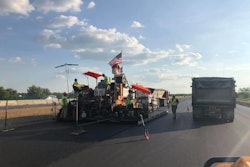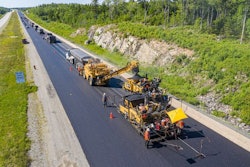
If the construction industry is going to emerge stronger post-COVID, we need to rethink both the projects we build and the way we build them. Many technologies are being developed to do just that and projects around the country are emerging showcasing what the future of the industry may look like.
The American Society of Civil Engineers (ASCE) has designated 13 new Infrastructure Gamechangers—groundbreaking infrastructure projects and programs that represent the latest innovations in transportation, water and energy infrastructure that are transforming the way engineers plan, build and adapt to the nation’s infrastructure needs. Following these new additions, 40 states are now represented by a Gamechanger that meet at least one of these criteria: innovative technologies, creative funding mechanisms, trend-setting standards, and unique collaborations between agencies or private firms.
“Our nation’s infrastructure just received a ‘C-‘ in ASCE’s 2021 Infrastructure Report Card, which is not the type of grade you want to bring home,” said ASCE President Jean-Louis Briaud, Ph.D., P.E. “Promoting innovative practices, principles and projects are one of the ways in which we can improve this grade. With resources stretched thin, finding solutions that can make the most of the tools afforded us can be a challenge, but is an essential component of improving the built environment. This year’s Gamechangers are a testament to the forward-thinking nature of the engineering community.”
The latest additions to ASCE’s Infrastructure Gamechangers are:
- Amtrak’s new Acela train has increased its speed by 10 miles an hour – up to 160 mph -- which is expected to trim 15 minutes off a trip between D.C. and Boston. Additionally, the new trains can carry 380 passengers, 25% more than current fleets, while using 20% less energy. The $2.4 billion modernization effort continued throughout the pandemic, keeping much-needed jobs alive during the crisis.
- Arizona Department of Transportation’s (ADOT) I-10 Dust Detection and Dynamic Response System was put in place to mitigate the significant role dust storms play in crashes and fatalities along the I-10 stretch between Phoenix and Tucson. A combination of short-range dust gages and a long-range weather radar dish that can detect dust storms from over 40 miles away feed into a closed-circuit camera system. ADOT can then dynamically slow speed limits and update message boards to keep drivers safe through adverse conditions.
- Atlanta, Georgia startup RanMarine’s “WasteShark” drone travels through waterways to collect litter, biomass, microplastic and other debris using a basket underneath the device. In addition to removing litter, the drone also collects data on water conditions. Sensors allow the WasteShark to analyze water temperature, pH levels, depth, green algae, or hydrocarbons in oil.
- Cary, North Carolina flood prediction monitoring system is set to save the flood-prone town millions of dollars in unnecessary damages. The town partnered with SAS and Microsoft to create a system which uses wireless sensors and rain gauges to detect water rising in local sources, which is then transmitted to a database where officials can see expected water level rise based on the current data. Once transmitted, the town uses an Internet of Things platform to send alerts to all local departments so that preparations can be made to mitigate floods.
- Columbus, Ohio Smart Circuit autonomous shuttle bus is a free service which covers a downtown route (the Scioto Mile) and a route in the Linden neighborhood in northeastern Columbus. The vehicle seats 15-passengers and can serve up to 90 passengers per hour. The city’s Scioto Mile route was one of the first of its kind when it was unveiled in 2018, and the more recent Linden Mile route opens the door for more neighborhood environment autonomous shuttles.
- Hillsboro, Oregon In-Pipe Hydroelectic Project converts excess water pressure to carbon-free electricity and is the first renewable energy project that features In-PRV smart water technology. The groundbreaking technology is expected to generate anywhere from 185,000 to 200,000 kWh of electricity per year, which will be used for electric vehicle (EV) charging stations and a local recreation center. Installation of this technology will reduce more than 162,000 pounds of carbon annually – or the equivalent of 240,000 driven miles off the road every year.
- Indiana Department of Transportation’s (INDOT) Concrete Sensors allow the agency to better understand exactly how far along concrete is in the maturation process. By leaving the sensors within the concrete for an extended period, engineers can study the effectiveness of their work over time, as opposed to the conventional testing period of just 28 days. This also will communicate to INDOT when concrete needs to be replaced.
- Long Ridge Energy Terminal in Hannibal, Ohio has transitioned to running on carbon-free hydrogen by way of blending hydrogen in the gas stream, allowing the plant to burn 100% green hydrogen over the next decade. This is the first hydrogen-burning power plant in the U.S. and the first that blends hydrogen in its gas turbine in the world. Long Ridge teamed with GE Power for the $588-million project to use an H-class gas turbine, which can initially burn 15% to 20% hydrogen before transitioning to 100% hydrogen over time.
- Massachusetts Department of Energy Resources’ Clean Peak Energy Standard (CPES), the first CPES in the nation, is designed to provide incentives for utilities to use clean energy technologies that supply electricity or reduce demand during seasonal peak demand periods. The Energy Storage Association (ESA) said the reduction in infrastructure costs should save ratepayers $710 million over the next decade and reduce carbon emissions by 560,000 metric tons in the first 10 years.
- Michigan Department of Transportation’s (MDOT) autonomous boat-like device EMILY is used to inspect bridge scour beyond what is usually possible during human dives. MDOT partnered with the Great Lakes Engineering Firm on the small EMILY device, which uses cameras and sonar technology to investigate bridge scour before determining if a crew member needs to get in the water.
- Neo, by California-based TechniSoil Industrial, is a recycled road substance created by blending recycled plastics with reclaimed asphalt pavement. The company mills the existing roadway and mixes a polymer-infused substance with the reclaimed pavement, and then immediately re-paves the recycled substance, known as Neo, back onto the road. Neo uses 150,000 plastic bottles per lane mile to create a 90% reduction in greenhouse gas emissions, a decrease of 84 truckloads per mile of hauling waste asphalt out and new asphalt in, and provides the opportunity for same-day returns to traffic. The Neo roadways are expected to last three times longer than asphalt and are about five times as strong as traditional materials.
- North Dakota Department of Transportation’s (NDDOT) Autonomous Impact Protection Vehicle is used to protect construction crews from other drivers on the road who may not be paying attention to the construction site or have lost control of their vehicle. In 2019, 234 work zone related crashes occurred on North Dakota highways, resulting in 64 injuries and two fatalities. Usually driven by a human, this vehicle is remotely controlled by a crew member without any other crew members inside to reduce potential risks.
- Port of Los Angeles’ Port Optimizer program created a single tool for the many port stakeholders, including shipping lines, marine terminals, motor carriers, and railroads to tap into when looking for operational improvements. The Port of Los Angeles is the largest container port in the nation and one of the largest in the world, so an efficient operation is key to the regional economy. Productivity is estimated to grow 8-12% as throughput is improved, operations predictability becomes the norm, and customers receive an average of 14 days of advance visibility.
These projects are just a sample of the incredible innovations happening in the industry that can help address the challenges our systems face across the country, which were outlined in the 2021 Report Card for America’s Infrastructure, released March 3rd. The Report Card assessed 17 categories of infrastructure and assigned a cumulative GPA of ‘C-‘, a modest improvement from the ‘D+’ given in 2017.
For more information on ASCE’s Infrastructure Gamechangers, go to https://www.infrastructurereportcard.org/solutions/gamechangers/.




















